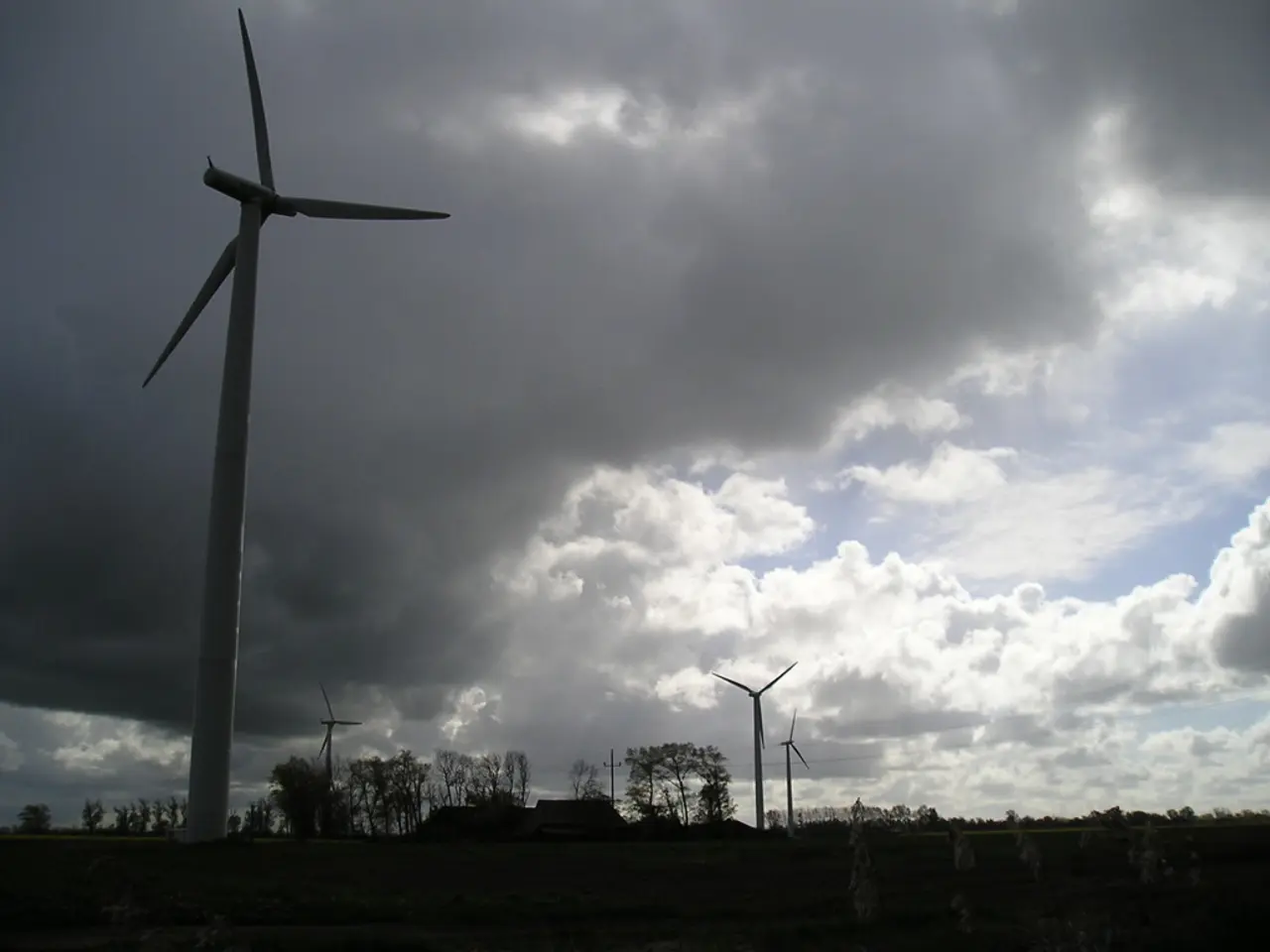Trump proposes stricter regulations for wind and solar energy through executive action
In a significant move, President Donald Trump's executive order has tightened eligibility requirements for federal tax credits available to wind and solar energy projects in the United States. The directive, tied to the "One Big Beautiful Bill Act," aims to prevent what it describes as the "artificial acceleration or manipulation of eligibility" and crack down on developers who might use legal or financial strategies to meet tax credit deadlines without substantive progress on the ground [1][2].
The new order significantly shortens the window for tax credit eligibility, requiring that physical construction commence within a year for projects to qualify for tax relief. Additionally, the Treasury Department has been instructed to enforce stricter rules, narrowing the use of "broad safe harbors" and requiring a significant portion of the facility to be physically built before it can be deemed eligible [1].
The executive order's impact on capital investment and project development is expected to be substantial. By reducing financial incentives for new wind and solar projects and creating uncertainty, investors may be discouraged from long-term capital investment in the renewable energy sector. This could lead to project cancellations and delays, particularly for projects that were in early planning or that require longer lead times due to permitting, financing, or supply chain issues [2].
The policy shift is also expected to accelerate project timelines, compressing development schedules and forcing some projects to abandon pre-construction planning. Advocacy groups and analysts predict that tighter eligibility will result in fewer projects, job losses, and less renewable energy capacity coming online. This could lead to higher electricity prices and make the grid less reliable, particularly during periods of high demand [2][4].
The executive order appears to make good on a deal Trump reportedly struck with the Freedom Caucus, in which he promised to use his executive powers to further curtail federal subsidies on wind, solar, and electric vehicles in exchange for their support [5]. However, the transferable tax credit market, including manufacturing, nuclear, battery storage, geothermal, carbon sequestration, clean fuels, and hydropower, remains robust moving forward [6].
The preservation of the tax credit transferability mechanism is seen as a positive for the industry by Godfrey. Projects that don't manage to commence construction before July 4 next year "will get cut off at the knees," according to Harry Godfrey, who leads Advanced Energy United's federal policy team [7]. Projects in early to mid-stage development, expected to help with a supply shortfall in the latter part of this decade, are anticipated to be acutely hit by the recent bill [8].
The budget legislation signed into law on July 4 slashed the eligibility for the 45Y and 48E clean energy tax credits for wind and solar projects, potentially leading to a $500 billion reduction in capital investment in U.S. electricity and clean fuels production over the next ten years [9]. The tight eligibility standards for projects in development are expected to lead to uncertainty around capital investment [10].
The order also instructs the Secretary of the Treasury to implement the enhanced Foreign Entity of Concern restrictions in the law and revise any identified regulations, guidance, policies, and practices to eliminate any preferences for wind and solar facilities [11]. Wind and solar projects face another significant hurdle in convincing their financiers that they can meet the tight construction timelines [12].
It is worth noting that the bill introduces complex FEOC rules that may affect the advanced manufacturing 45X credit, although the long-term continuation of the credit is expected [13]. Hasan Nazar, head of policy at Crux, states that the transferable tax credit market remains robust moving forward [14].
References: [1] https://www.reuters.com/business/energy/trump-orders-treasury-tighten-tax-credit-eligibility-wind-solar-projects-2021-06-04/ [2] https://www.bloomberg.com/news/articles/2021-06-04/trump-s-executive-order-to-tighten-tax-credit-eligibility-for-wind-and-solar-projects [3] https://www.forbes.com/sites/jamesconca/2021/06/07/trump-administration-makes-it-harder-for-wind-and-solar-energy-projects-to-get-tax-credits/?sh=56e821d7765c [4] https://www.axios.com/trump-executive-order-wind-solar-energy-tax-credits-4b7d34d9-15d0-4535-8b60-1f1a0969849a.html [5] https://www.axios.com/trump-freedom-caucus-deal-renewable-energy-tax-credits-56e21694-90f2-4063-85d6-f3e4261d3b7f.html [6] https://www.axios.com/trump-executive-order-wind-solar-energy-tax-credits-56e21694-90f2-4063-85d6-f3e4261d3b7f.html [7] https://www.axios.com/trump-executive-order-wind-solar-energy-tax-credits-56e21694-90f2-4063-85d6-f3e4261d3b7f.html [8] https://www.reuters.com/business/energy/trump-orders-treasury-tighten-tax-credit-eligibility-wind-solar-projects-2021-06-04/ [9] https://www.bloomberg.com/news/articles/2021-07-04/trump-s-budget-bill-slashes-tax-credit-eligibility-for-wind-solar-projects [10] https://www.bloomberg.com/news/articles/2021-06-04/trump-s-executive-order-to-tighten-tax-credit-eligibility-for-wind-and-solar-projects [11] https://www.reuters.com/business/energy/trump-orders-treasury-tighten-tax-credit-eligibility-wind-solar-projects-2021-06-04/ [12] https://www.bloomberg.com/news/articles/2021-06-04/trump-s-executive-order-to-tighten-tax-credit-eligibility-for-wind-and-solar-projects [13] https://www.reuters.com/business/energy/trump-orders-treasury-tighten-tax-credit-eligibility-wind-solar-projects-2021-06-04/ [14] https://www.reuters.com/business/energy/trump-orders-treasury-tighten-tax-credit-eligibility-wind-solar-projects-2021-06-04/
- The executive order's tightened eligibility requirements for renewable energy tax credits may lead to a decrease in capital investment in the industry due to the reduced financial incentives, potentially discouraging long-term investments in wind and solar projects.
- The policy shift could result in fewer renewable energy projects, causing job losses and less renewable energy capacity coming online, thereby potentially increasing electricity prices and making the grid less reliable, particularly during periods of high demand.
- Despite the tightened tax credit eligibility for wind and solar projects, the transferable tax credit market for other renewable energy sources such as manufacturing, nuclear, battery storage, geothermal, carbon sequestration, clean fuels, and hydropower remains robust.




